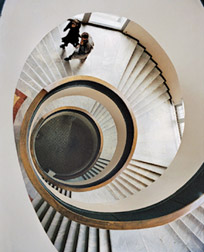At the Royal Academy
Tony Wood
Architecture had a shifting status within Russian modernism: first
younger sibling, then domineering older brother. The riot of avant-garde
experimentation and iconoclasm began in painting and literature in the
years before the First World War; many totemic works date from this
period - Malevich's Black Square, Bely's Petersburg, Goncharova's
Cyclist. The Revolution brought an accelerating radicalism in the arts,
but the devastation of the Civil War years meant that this creative
ferment found expression mostly on paper, canvas or plywood.
It wasn't until after 1921 that Russian architecture produced its
great modernist landmarks. The following decade and a half brought an
astonishing wave of formal innovation, driven at once by utopian energy
and dire need; across the USSR, scores of buildings went up - apartment
blocks, schools, garages, government offices, workers' clubs - marked by
a combination of elegance and austerity.
 By the mid-1930s, however, the Party had brought all the arts to
heel, and avant-garde impulses were constrained or cancelled by the
emerging stylistic canons of Socialist Realism. Architecture now became
a privileged realm for the development of a Stalinist visual idiom: a
heavy, bombastic classicism that still dominates the streetscape of many
Russian cities, overshadowing the isolated remnants of the 1920s. By the mid-1930s, however, the Party had brought all the arts to
heel, and avant-garde impulses were constrained or cancelled by the
emerging stylistic canons of Socialist Realism. Architecture now became
a privileged realm for the development of a Stalinist visual idiom: a
heavy, bombastic classicism that still dominates the streetscape of many
Russian cities, overshadowing the isolated remnants of the 1920s.
Building the Revolution, at the Royal Academy until 22 January, spans
two extraordinary decades, 1915-35, and brings together an impressive
range of paintings, drawings and photographs.
Architecture is the main focus, represented both in archival images
and Richard Pare's remarkable photographs from the 1990s and 2000s;
there is also a selection of works by artists such as Rodchenko, Popova,
Lissitzky and others, demonstrating the extent to which the concerns of
the different branches of the arts were intertwined in the period.
Indeed, the previously separate disciplines of painting, sculpture,
architecture and design were integrated after the Revolution, in
institutions such as VKhUTEMAS ('Higher Artistic and Technical
Workshops').
From an early stage, architectural thinking permeated the Russian
avant-garde as a whole: notions of 'construction' played a central role
in Popova's Painterly Architectonics series - dynamic compositions of
lines and irregularly shaped planes of vibrant colour. Perhaps the most
celebrated example, however, is Tatlin's planned monument to the Third
International, a double helix of girders spiralling around stacked
geometric forms. As a prelude to the exhibition, a ten-metre high model
of Tatlin's Tower has been installed in the stately Annenberg Courtyard
(named for Nixon's ambassador to the UK, ironically enough). Though the
monument was never built, it found an echo in Shukhov's radio tower of
1922, which consists of a series of steel hyperboloids; the angular
perfection of its latticework was often deployed as a symbol for the
modernity to which the USSR aspired.
In the Soviet architecture of the 1920s, a characteristically
modernist attention to function and materials was combined with an
urgent project of social transformation. Collective forms of living,
eating, socialising and sleeping provided new parameters within which
architects worked. The student housing designed by Ivan Nikolaev for the
Textile Institute in Moscow in 1929-31 envisaged a communal existence,
with shared dormitories and facilities. The building has a striking
lightness to it: clean lines and an unadorned exterior with ramps for
ease of circulation within. Above all, it is designed on a human scale,
in stark contrast to the gigantism of high Stalinist constructions.
Of course, the avant-garde was not immune to the lure of the big
statement: the 1929 Gosprom building in Kharkov, a series of
severe-looking concrete and glass volumes connected by elevated
walkways, encircles almost half of Ploshchad Svobody. But in many ways
what is most impressive about the buildings of the period is the way
they seek to make formal ingenuity practically useful. The bakery on
Khodynskaia Street in Moscow, built by Georgi Marsakov in 1931, makes an
aesthetic virtue of the production line, arranging the different stages
of the process in a series of circles which in turn give the building
its shape - form truly issuing from function.
More dazzling still is the work of Konstantin Melnikov, a maverick
figure within the avant-garde best known for designing the USSR pavilion
at the 1925 Paris Expo. Between 1927 and 1930, he built a remarkable
series of garages and workers' clubs - each of them an idiosyncratic
one-off, as different from each other as from the buildings of
Melnikov's peers.
The Rusakov club in north-eastern Moscow, built for the municipal
workers' union in 1927-29, consists of three cantilevered volumes
fanning out from a central stage area; these three seating blocks could
be used simultaneously and the stage subdivided various ways, allowing
flexible use of the space.
The Gosplan garage, built in 1936, combines the solid functionality
of its main block with an expressive flourish reminiscent of art deco: a
large circular window ringed with plasterwork fluting that gives it the
appearance of an open eye.
- London Review of Books
|



